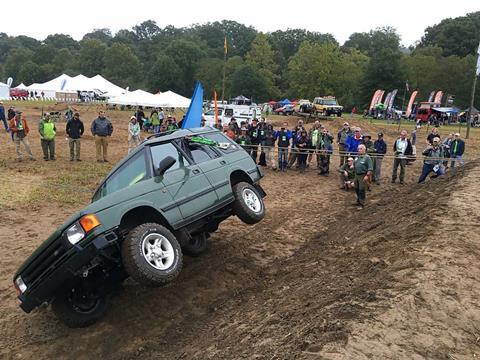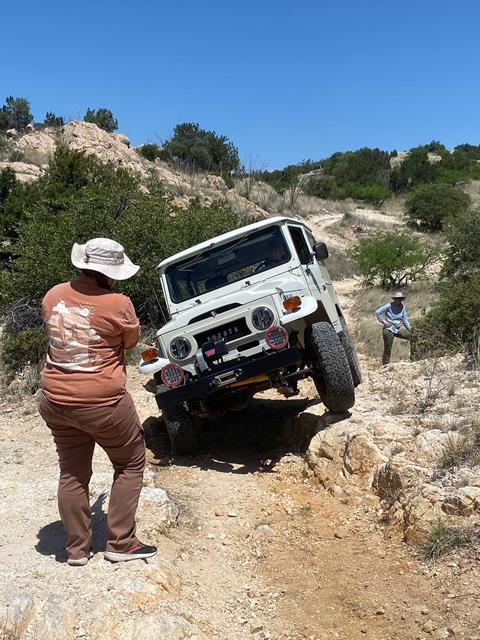I remember my first experience negotiating a side slope in my 1973 Toyota Land Cruiser—some decades ago now. I was a rank novice, learning the basics of low-range driving by trial and error on the trails in the mountains east of Tucson.
At one spot I found myself faced with a climbing turn that leaned alarmingly toward the driver’s side. I inched up it in first gear, thinking that if other vehicles had made it through an FJ40 certainly could as well.

By the apex I was white-knuckled on the steering wheel, certain I must be approaching the 35-degree angle I’d read somewhere was the safe limit for a Land Cruiser. I released a long-held breath when the vehicle finally settled back toward horizontal.
Shortly thereafter I bought a stick-on Lev-O-Gauge, applied it to the dash, and revisited the same spot. I crept forward until I was at maximum lean angle, then stole a glance at the gauge.
It read—whaaat?—21, maybe 22 degrees. I was humiliated.
Since then I’ve become far more comfortable with side slopes, and I have explored some angles that would have made me faint back then. But I’ve never become so cavalier as to treat crossing a hillside with anything but caution. I’ve witnessed the results when others have neglected to do so.
What They Don’t Tell You
Almost all 4x4 manufacturers list approach, departure, break-over, even wading-depth figures for their models. Very few publish a side-slope angle—and for good reason.
It would be easy to put a vehicle on a hydraulic tilt table with a safety strap, crank it over until it unloads the upside tires, subtract a degree or two, and advertise that number as the side-slope capability. It would also be stupid.

There is far, far more complexity to negotiating side slopes than simply memorizing a number and making sure you stay under it on whatever tilt-o-meter you’re using—a stick-on model, the vehicle’s own pitch and roll function, or your iPhone in a Quad-Lock mount.
The Variables
Start with the vehicle itself—let’s say one with a theoretical 40-degree side-slope rating. What happens when you add a suspension lift? Larger tires? Fridge? Winch? A roof rack and, heaven forbid, a roof tent and awning? How about adding a second 45-pound battery on one side of the vehicle? For that matter, how much do you weigh, and are you carrying passengers?
There are uncountable variables—and not all of them necessarily detrimental. We have a 24-gallon water tank located between the chassis rails of our 70-Series Land Cruiser Troopy; when full, it probably adds a bit to our safe angle.

Even if you were able to re-test your vehicle in completely trail-ready condition, side slopes are not static, perfect gradients, but dynamic environments with continuously changing angles due to varying substrates and weather-related conditions, erosion, ruts from previous traffic—sheer chaos compared to the tilt table with the safety strap.
You might be naively trundling along in your 40-degree-rated vehicle on a slope your iPhone tells you is “only” 35 degrees, and have your front tire bounce over a rock, which together with your momentum bumps you up to 41 degrees, and … oops.
How It’s Done
So, what’s the best way to handle a side-slope situation? You could follow the first line of the section on cross-slope driving in the syllabus for the British National Proficiency Test Council’s examination for competency in 4x4 driving, which says, “Avoid if possible.”
Good advice, but rarely practical if you’re doing any sort of serious remote exploration. Instead, you need to evaluate each situation within the context of your own vehicle and the slope you’re facing.
The first rule, obviously, is to only follow previous tracks. Prior, repeated success by other drivers is a good indication that the slope is negotiable. Next, note the conditions.

A well-traveled slope that’s recently been rained (or snowed) on might be an entirely different beast than it was when those tracks were made. Is the track clearly delineated, or are there multiple tracks—or, worse, an illegal “princess trail” cross country to avoid it altogether? Is there evidence of previous vehicles sliding downhill? How difficult would it be to retreat in reverse if you decided to do so mid-slope?
Once you commit to giving it a go, the best speed to maintain on a slope (or a boulder over which one side of the vehicle needs to drive) is the slowest one possible to avoid bouncing an uphill tire off a hidden rock or hump that would tip the vehicle farther.
So, first gear low range, and if it’s necessary to brake use your left foot if you have automatic transmission to avoid the tiny lag time involved in switching pedals and to ensure a smooth transition from power to brake. Keep a firm, thumbs-out grip on the wheel to maintain the line you need, and be ready to correct quickly but conservatively if the rear end skips downhill slightly.
If there’s a precipitous drop-off on one side of a narrow, sloping trail and a precipitous uphill on the other, most drivers will instinctively try to hug the uphill, even to the point of putting the wheels up higher than necessary. This increases the chances of sliding downhill or bouncing off something that would either tip the vehicle even more or actually bump it toward the outer edge. It’s better to keep the vehicle in the track and as level as possible.
A Matter of Angles & Degrees
One rough and ready tip I’ve shown many drivers unsure of the slope capability of their vehicles—or of themselves—is to stop when you feel you’re tipping close to hazardously. Shut off the engine, secure the transmission and parking brake, and get out and stand behind the vehicle on the downhill side.

Draw an imaginary line vertically through the vehicle from the outside of the tires. I’m willing to bet you’ll discover that a significant majority of the mass is still safely on the uphill side of the line. It’s also good practice to marshal other drivers across side slopes to get an external view of the angles involved.
So what about those theoretical angles? After years of running field classes and guiding hundreds of attendees around the driving courses at the Overland Expo, I’ve found that most newcomers to 4x4 driving start to get very nervous at about 20 degrees (just like I did). Virtually all standard 4x4 vehicles are perfectly safe at that angle.

At 25 degrees even experienced drivers begin to pay close attention. And anything beyond 30 degrees should be negotiated with undivided concentration. (Rock buggy drivers will laugh at this, but that’s a different species of 4x4.) Above 30 degrees you’re entering a realm where the vehicle could slide sideways, possibly with an abrupt halt in a rut or on a rock that could tip you dangerously. Be skeptical of boasts from internet “experts”—I recently read a post on a 4Runner forum from a guy who claimed he was “comfortable at anything up to 50 degrees.” I call BS on that one.
Degrees vs Percentages
Incidentally, be sure you understand the difference between a slope measured in degrees and one measured in percentage. A 45-degree slope—that is, one halfway between horizontal and vertical—is a slope of 100 percent, indicating a rise of one foot for every foot forward. Thus a 50-percent slope would be 22.5 degrees—significantly less hazardous than a 50-degree slope!
Gone Too Far?
Suppose the very worst happens and you find the vehicle irretrievably tipping over or sliding off the edge of the trail? Immediately turn downhill and give the throttle a jab to get the wheels pointed downhill. No matter how steep the slope, you are better off headed straight down it on your wheels rather than barrel-rolling down.
Final Thoughts
The best way to gain confidence dealing with side slopes is in the controlled environment of a driving course with firm substrate and known angles. It will go a long way toward reducing that white-knuckle feeling when the horizon tilts through the windscreen.
Access More Great Stories!
This article originally appeared in OVR Issue 05. For more informative articles like this, consider subscribing to OVR Magazine in print or digital versions here. You can also find the print edition of OVR at your local newsstand by using our Magazine Finder.





















No comments yet